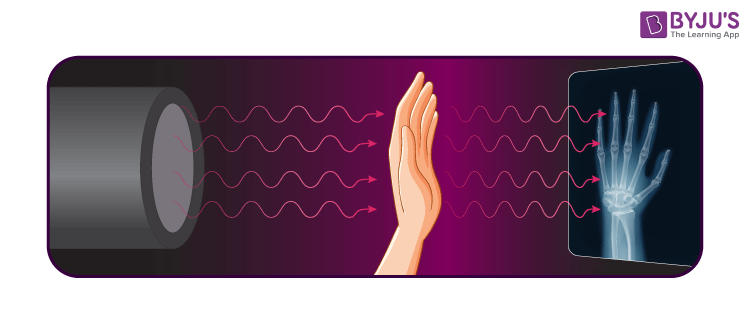What Are X-Rays?
We can define X-Rays or X-radiation as a form of electromagnetic radiation. They are powerful waves of electromagnetic energy. Most of them have a wavelength ranging from 0.01 to 10 nanometres, corresponding to frequencies in the range 3 × 1019 Hz to 3×1016 Hz and energies in the range 100 eV to 100 keV.
Who invented the X-Ray?
German physicist Wilhelm Röntgen is typically credited for the discovery of X-Rays in 1895 because he was the first to comprehensively study them, though he is not thought to be the first to have seen and perceived their effects.
Watch the video and learn about the discovery of X-rays

They were found emanating from Crookes tubes, experimental discharge tubes invented around 1875, by scientists looking into the cathode rays, that is energetic electron beams, that were first formed in the tubes.
How Do X-Rays work?
They are produced when high-velocity electrons collide with the metal plates, thereby giving the energy as the X-Rays and themselves absorbed by the metal plate.
- The X-Ray beam travels through the air and comes in contact with the body tissues, and produces an image on a metal film.
- Soft tissue like organs and skin, cannot absorb the high-energy rays, and the beam passes through them.
- Dense materials inside our bodies, like bones, absorb the radiation.

Much like a camera, the X-Ray film develops depending on the areas which were exposed to the X-Rays. White areas show the denser tissues, such as bones that have absorbed the X-Rays whereas black areas on an X-Ray represent areas where the X-Rays have passed through soft tissues.
Properties of X-Rays
The X-Rays properties are given below:
- They have a shorter wavelength of the electromagnetic spectrum.
- Requires high voltage to produce X-Rays.
- They are used to capture the human skeleton defects.
- They travel in a straight line and do not carry an electric charge with them.
- They are capable of travelling in a vacuum.

Types of X-Rays
Medical science recognizes different types of X-Rays. A few important types of X-Rays are given in the points below.
- Standard Computed Tomography
- Kidney, Ureter, and Bladder X-ray
- Teeth and bones X-rays
- Chest X-rays
- Lungs X-rays
- Abdomen X-rays
X-Rays Uses
Since the discovery of X-radiation, they are used in various fields and for various purposes. Some key uses of X-Ray are given below.
- Medical Science
- Security
- Astronomy
- Industry
- Restoration
Read More: Electromagnetic Spectrum
Medical Use:
They are used for medical purposes to detect the breakage in human bones.
Security:
They are used as a scanner to scan the luggage of passengers in airports, rail terminals, and other places.
Astronomy:
It is emitted by celestial objects and are studied to understand the environment.
Industrial Purpose:
It is widely used to detect the defects in the welds.
Restoration:
They are used to restoring old paintings.
Suggested Videos
Atoms and X-Rays – Important Topics

Atoms and X-Rays – Important Questions

Frequently Asked Questions
How are X-rays produced in a normal X-ray machine?
In a normal X-ray machine, X-rays are produced by bombarding cathode rays on a radioactive material. When a high speed cathode ray falls on a radioactive material, there is an emission of electrons and energy. This energy is used in the X-ray machine.
Name the term used for describing the dental X-ray.
Orthopantomography is the term that is used for describing the dental X-ray. In dentistry, X-rays are used for detecting the deformities, diseases, in growths, and the outgrowths. It is used for studying the structure of the teeth.
Which organ needs the longest exposure to X-ray?
Spine needs the longest exposure to X-ray. Spine is exposed for 0.20 seconds to get the proper image.
Where can X-rays be recorded?
X-rays can be recorded on a plate coated with silver halide. When silver halide plates are exposed to the heat, they start turning black resulting into images that are obtained as X-ray images.
What is the minimum distance at which X-ray is being taken?
50 m is the minimum distance at which X-ray is being taken.
If you wish to learn more Physics concepts with the help of interactive video lessons, download BYJU’S – The Learning App.

Comments